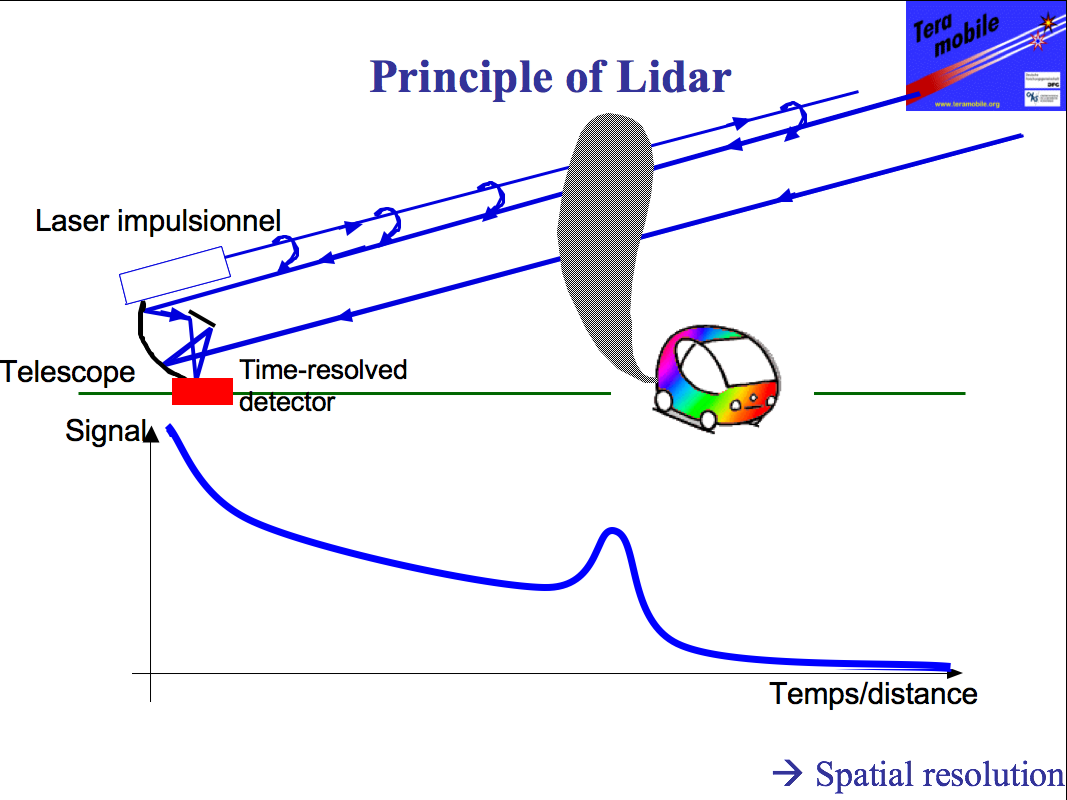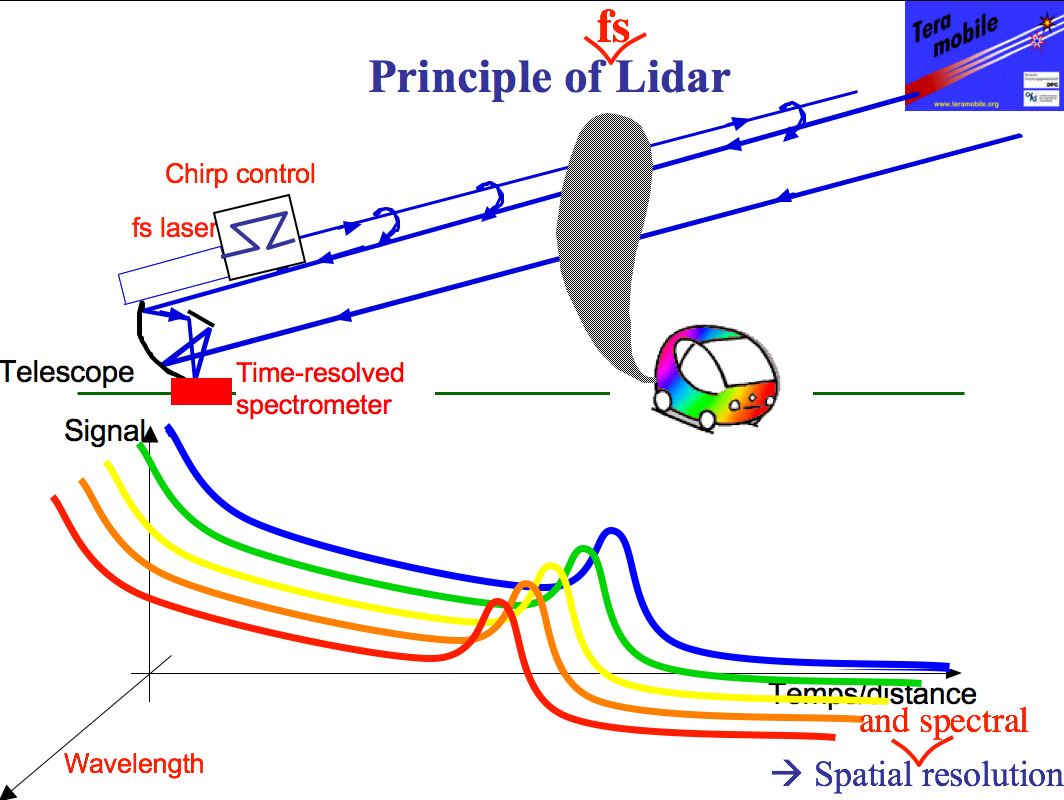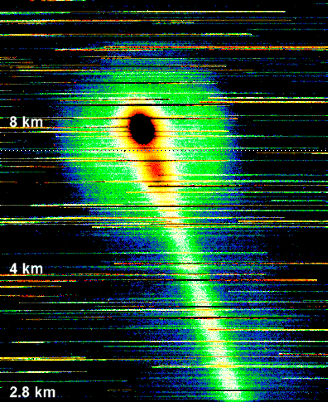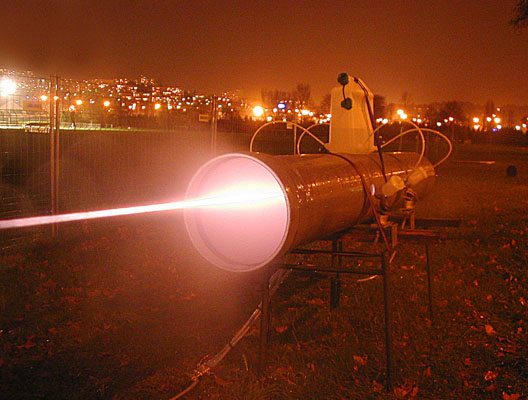
Teramobile
The first mobile terawatt laser in the world for atmospheric
studies
An international collaboration
Teramobile is an international project initiated jointly by a French-German
collaboration of CNRS (France) and DFG (Germany). It is now funded by ANR and implies
five
research institutes in Berlin, Dresden, Lyon, Palaiseau and Geneva.
The project aims at investigating nonlinear propagation
of femtosecond-terawatt laser pulses over long distances in the atmosphere,
and their applications to atmospheric research. This includes Lidar remote sensing of atmospheric pollutants as well
as lightning protection and triggering by a mobile Terawatt laser system.
The Teramobile system: A unique tool
The Teramobile system is the first mobile laser yielding 5 terawatts (TW)
and 100 fs (10-13 s) pulses, with 350 mJ pulse energy at 10
Hz repetition rate. It concentrates the state-of-the-art laser technology
in a 20’ standard freight container, allowing field measurement campaigns.
The laser system itself (Figure 1) has been built by Thales Laser (Palaiseau, France),
on a special compact design defined in common. The mobile laboratory (Figures
2) was concieved with Impres (Brehmen,
Germany).
 Figure 1. Teramobile laser.
Figure 1. Teramobile laser.

 Figure 2. Teramobile mobile laboratory
Figure 2. Teramobile mobile laboratory
Nonlinear propagation of laser pulses
High power (TW) ultrashort laser pulses (100 fs or less) propagating in
transparent media induce a change to the refractive index of air: this is
the Kerr effect, which has a focusing-effect. This effect is balanced by diffraction
caused by the plasma created by the high-intensity pulse (see Figure 3).
This leads to a dynamic equilibrium, and hence to self-guided filaments (Figure
4).
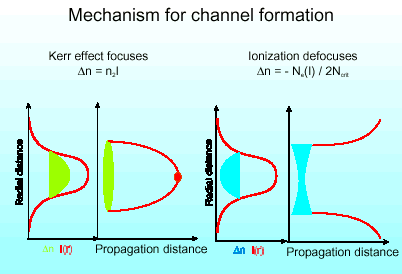 Figure 3. Principle of self-guiding
(click on the image for a higher-quality PDF version of the figure)
Figure 3. Principle of self-guiding
(click on the image for a higher-quality PDF version of the figure)
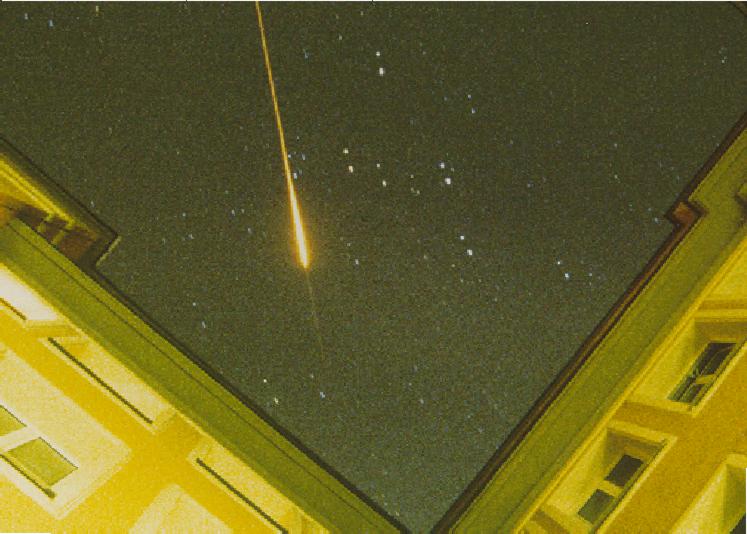 Figure 4. Photograph of a self-guided filament induced in air by
a high-power, infrared (800 nm) laser pulse
Figure 4. Photograph of a self-guided filament induced in air by
a high-power, infrared (800 nm) laser pulse
In the filaments, nonlinear self-action of the laser pulse leads to strong
evolutions of its spatial (self focusing, self guiding, self-reflection),
spectral (four wave mixing, self phase modulation) as well as temporal (self-steepening,
pulse splitting) characteristics. Extensive work has been dedicated to the
characterization of such processes, from both the experimental and theoretical
points of view, on both short scales and at long distances. For example, we
have shown that
filamentation generatesbroadband « white light »
continuum (230 nm-4 µm). This « white-light laser »
covers the absorption band of many atmospheric pollutants
filaments can survive their propagation through hostile conditions (rain,
haze, turbulent atmospheres)
Please refer to the publications section for
more details.
Lidar application
Our fs-TW laser used as a « white-light laser » allows
simultaneous remote sensing of multiple pollutants, using the multispectral
Lidar technique (Figure 5). A white-light signal was observed up to 18 km
distance (Figure 6)
We have used these properties to characterize a urban ozone pollution episode,
measuring both ozone and aerosols. We also performed remote detection of simulants
of biological aerosols using two-photon excited fluorescence (Figure 7).
Figure 5. Principle of Lidar and white-light Lidar. Light pulses
are emitted in the atmosphere, where they are attenuated and backscattered.
The backscattered signal as a function of time, hence of distance, is collected
on a telescope, and permits to retrieve information about the components present
in the atmosphere. In the case of white-light Lidar, the signal is recorded
at several wavelengths, allowing measurements with both spectral and spatial
resolution.
Figure 6. White-light backscattering up to 18 km distance
Figure 7. Remote detection of biological aerosols. The tube in
the center of the picture is an open cloud chamber generating the bioaerosol
simulant The laser beam is arriving from the left.
Lightning application
Since the self-guided laser pulse ionizes the air on its path, the filaments
are conducting. The filaments are therefore virtual wires that could be used
for lightning triggering or guiding in order to protect sensitive spots such
as power plants or airports.
The Teramobile laser indeed permitted us to trigger and guide high-voltage
(1 MV) discharges along filamentation in air, reducing the breakdown
voltage by 30 %.
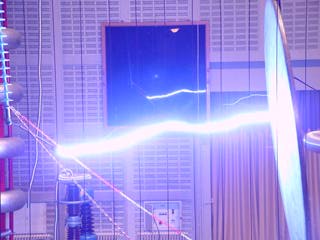
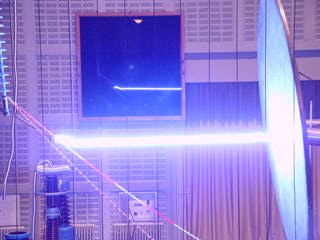 Figure 9. High-voltage lightning : without laser guiding (left),
with laser guiding (right)
The Teramobile project has been launched jointly by CNRS (France) and DFG (Germany). It is currently also funded by
ANR.
Figure 9. High-voltage lightning : without laser guiding (left),
with laser guiding (right)
The Teramobile project has been launched jointly by CNRS (France) and DFG (Germany). It is currently also funded by
ANR.



Last update 18/03/2008
Back to the Teramobile homepage







